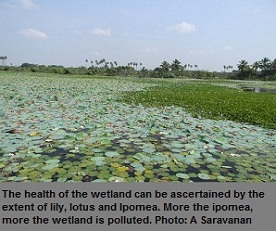Any and all opinions expressed in this newsletter are solely those of the author(s) and do not reflect the opinion of ATREE.
Centre for Excellence in Conservation Science
Royal Enclave,Srirampura,Jakkur Post
Bangalore-560064
Telephone: 080-23635555 (EPABX)
Fax : 080- 23530070
My interests in wetlands all started a few years ago when we put together the ‘Kulam Valam’ – a Tamil Newsletter about wetlandconservation. I interviewed mat weavers who brought my notice to the reeds and sedges that they collected from the wetlands. These were an important bio-resource for their livelihood. The water-fowl census then took me to many wetlands - yet another eye opener to know about the plants that play a major role in supporting bird life. Sometime later, the ACCC team came up with the idea of a guide for wetland plants, an off-shoot of a similar guide to wetland birds. Both the guides target the common people to help them readily identify plants along with the birds in the wetlands. I started my survey in April 2011 covering 80 wetlands. The inventory now comprises 93 plant species representing 46 families.Plants in wetlands are as diverse in structure and species composition as the plants that grow on land. Diverse habitats ranging from wet soil and shallow edges to deeper area with slush makes the tanks ideal home for diverse plant species. Plants in wetlands have diverse modifications to live in a habitat where the water is plenty. Wetland plants have specially modified roots, stem, leaf and flower systems that are adapted to aquatic conditions. Generally, these plant parts have air chambers that facilitate floatation and in extreme cases, as it is found in ‘netti’, they develop corky tissue around the stem. There are plants such as lotus and lilies which are rooted but their leaves and flowers float above the water surface. Water hyacinth floats freely on the water surface and its roots are submerged in the water scavenging for nutrients. Plants such as Vallisneria are rooted in the bottom and its leaves are submerged. Only its flowers stay above the water so that they are pollinated with the aid of ripples. Water quality is one of the controlling factors that determines the species composition and abundance of plants in wetlands.
As a preliminary work, we searched for frogs that are supported in the paddy fields. We later caught about 10 frogs of three species and delicately flushed their stomachs using established protocols to see what they eat. Surprisingly, we found them to eat a great diversity of insects. Our study will examine how many from their diet spectrum will qualify as 'Crop pest'. As to know what farmers know of frogs, we set out and released a photographic pocket field guide on frogs and toads of KMTR in Tamil. With the arrival of monsoon, more intensive surveys, both ecological and social will be carried out to solve the question that have been lurking in the mind for a while!
Polluted water can aid in the excess growth of single species such as water hyacinth which can rapidly multiply thereby reducing the chances for other species. Sunlight is another key factor for flowering, hence when water recedes one might see a large number of flowers. Summer would be the best time for avid botanists who are keen to collect some specimen.Humans are one of the major beneficiaries of many wetland plants and are known to harvest and utilize several parts of the plants. Roots and rhizomes such as ‘Amalai kizhangu’, ‘Kadal paalai’ and lotus are used as food and medicine while leaves are used as fodder and manure. Silt in the tank containing decomposed plants used as organic manure for paddy and banana. Flowers of lotus and lily are sold in temples and also used for medicinal purposes. Reeds are harvested to make mats. Wetland plants support birds, fishes, frogs, reptiles, snails, several micro organisms, apart from cattle and humans. It provides space and resources for nesting, roosting and feeding of resident as well as migratory birds. Some birds like jacana walk through the floating leaves for feeding. Swamphen, coots and jacanas nest on the floating vegetation which forms the ideal habitat for their food - snails, frogs and reptiles. Fishes get food from living and decomposing parts of plants and also take shelter in the entangled mass of plants.
These wetlands plants are beneficial not only to harbor biodiversity but also in improving human well being. Loss in wetland plants will be detrimental not just to wetland biodiversity but also to humans specially the marginalized communities.
Editorial Team
Editor: Allwin Jesudasan
Associate editor: Rajkamal Goswami
Editorial Review: R. Ganesan, M. Soubadra Devy, T. Ganesh
Design and presentation: Kiran Salagame
A S H O K A T R U S T F O R R E S E A R C H I N E C O L O G Y A N D T H E E
N V I R O N M E N T
Wetland plants – rarely seen and appreciated
- A Saravanan
If you have any suggestions or comments please let us know through the boxes below






